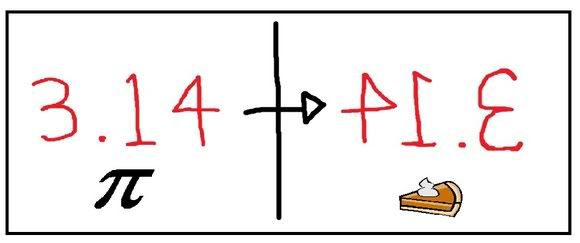 |
| Fun fact. Much of what we know about Archimedes was recorded by Vitruvius. I wonder if we could get Morgan Freeman to narrate some of Archimedes work... |
 |
| I honestly cannot tell if this is the most insightful thing I've heard today or useless. |
He also worked in mathematics. He gave an approximation of the square root of 3 (which was accurate to the hundred thousandths decimal). He calculated the area contained by a parabola and a straight line. He calculated the areas of triangles and parallelograms. He approximated π.
 |
| Coincidence? I think not. |
 |
| Yeah, instead of an epitaph, could you just carve my 9th grade essay on "Haroun and the Sea of Stories" onto a marble slate? |
AreaCircle = (Area of 1 Triangle) * (Number of Triangles)
ACircle = (1/2 * Circumference/n * r) * n
ACircle = 1/2 * C * r
Since C = 2πr, we know that
ACircle = 1/2 * 2πr * r
ACircle = πr2
Now Archimedes thought about the surface area of the sphere. He decided to first start by looking at the surface area of a section of the sphere, defined by a section of the sphere cut off by a plane slicing through the sphere.
Since we are looking at the surface area, let's imagine that the sphere is empty. It is just a shell that outlines the sphere. For reasons that will be clear very soon, let's think of the sphere as the empty casing around a spherical roast beef at Arby's.
 |
| [Insert Product Placement Here] |
 |
| "Isosceles. You know, I love the name Isosceles. If I had a kid, I would name him Isosceles. Isosceles Kramer." - Cosmo Kramer |
As the slices get thinner, the number of slices increases and the picture above starts to look like a triangle.
AreaCross Section = 1/2 * Circumference * Radius
ACS = 1/2 * C * r
Since C = 2πr, we know that
ACS = 1/2 * 2πr * r
ACS = πr2
Therefore, we know that the surface area of the portion of the sphere that is cut off by a plane slicing through the sphere is equal to the area of the circle defined by the intersection of the surface of the sphere and the plane. Now if we imagine that the plane cutting the sphere goes through the center point of the sphere, the radius of the intersection circle is equal to the distance from point (0, 0, r) to
(r, 0, 0). This distance is equal to √2r. Since this only calculates the surface area of the top half of the sphere, the surface area of the sphere is twice the area of the circle with radius √2r.
Surface AreaSphere = 2*π*Radius2
SAS = 2*π*(√2r)2
SAS = 4πr2
Now at this point, Archimedes kind of goes off the deep end. He started talking about approximating the volume of a sphere using pyramids. I looked at how he calculated the volume of a sphere and had the following reaction.
I don't quite understand it myself yet. There is a strong possibility that I write another blog post about more of Archimedes work, but for now
I don't quite understand it myself yet. There is a strong possibility that I write another blog post about more of Archimedes work, but for now




A fun read, Jim. Educational, engaging. Good job.
ReplyDeleteI emailed you an Archimedes activity. 5Cs:+ here.
ReplyDeleteI loved learning the history of math here. I think math classes could be more historical. Possibly have each student select a famous mathematician, like Archimedes and do a report on them to learn how they contributed to math, how they thought about math (their process), and generally learn mathematical history.
ReplyDelete